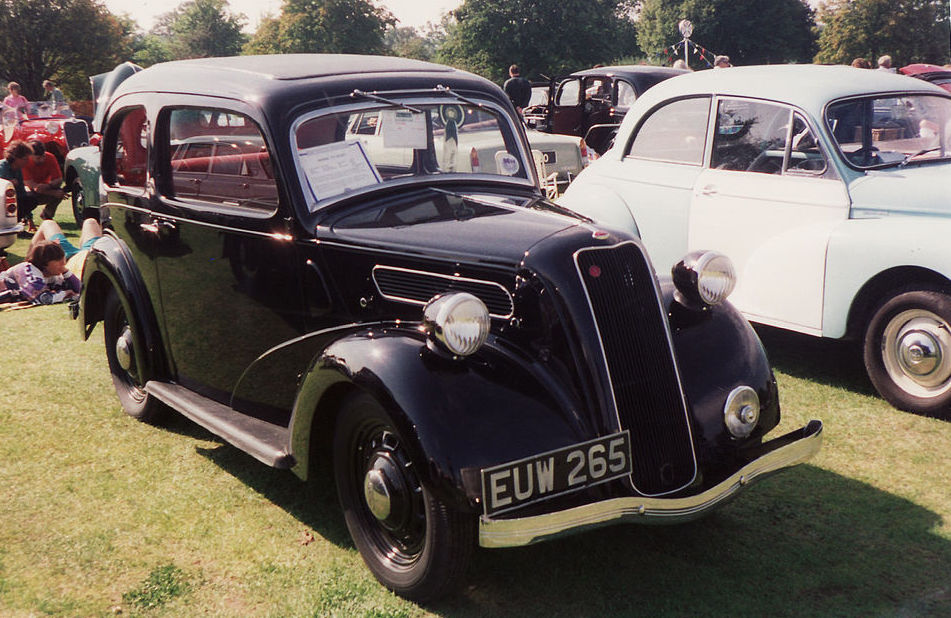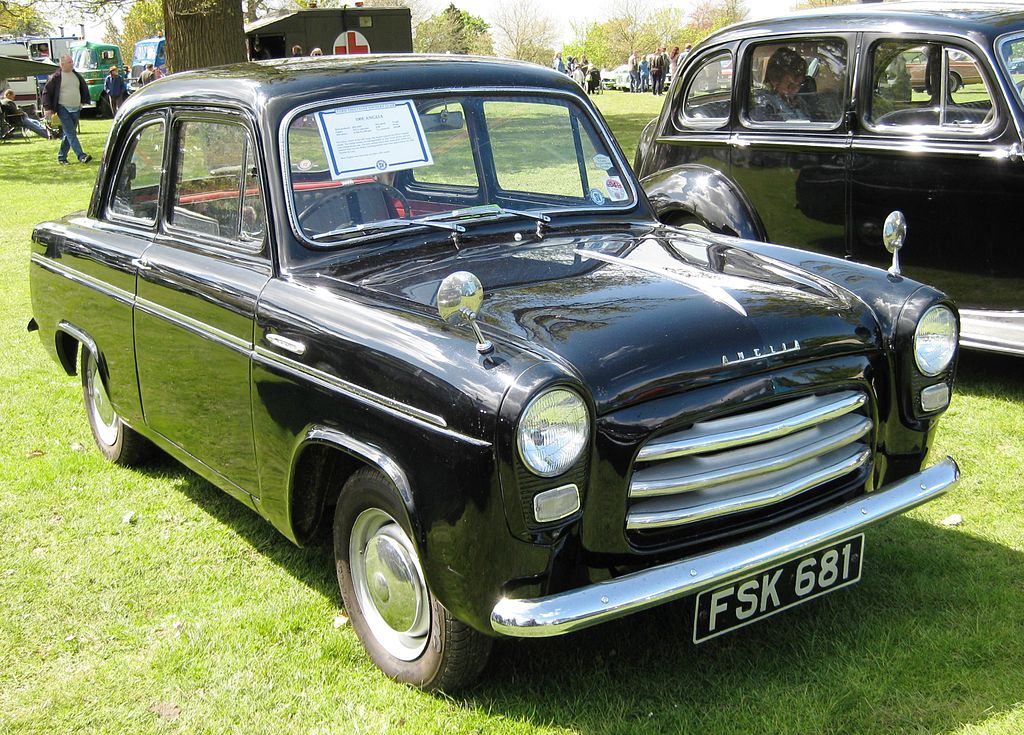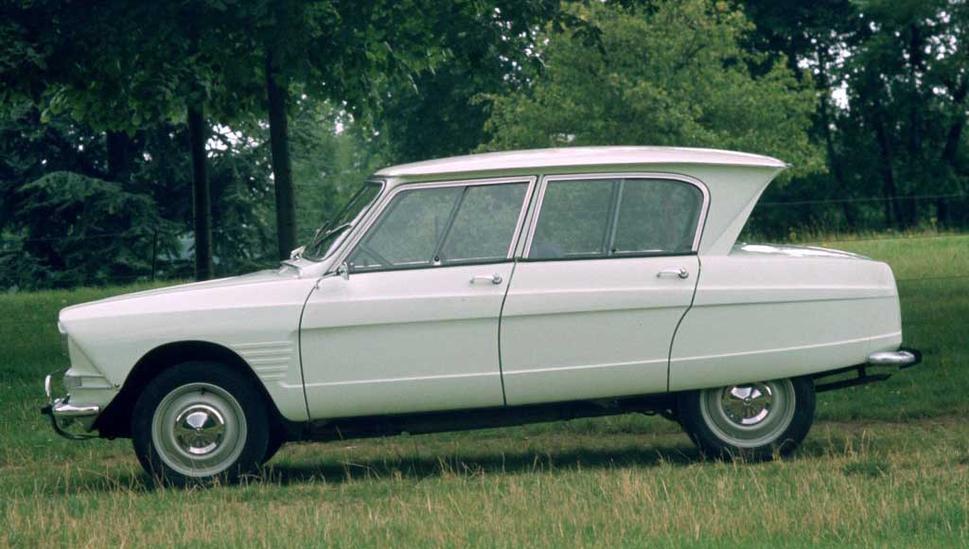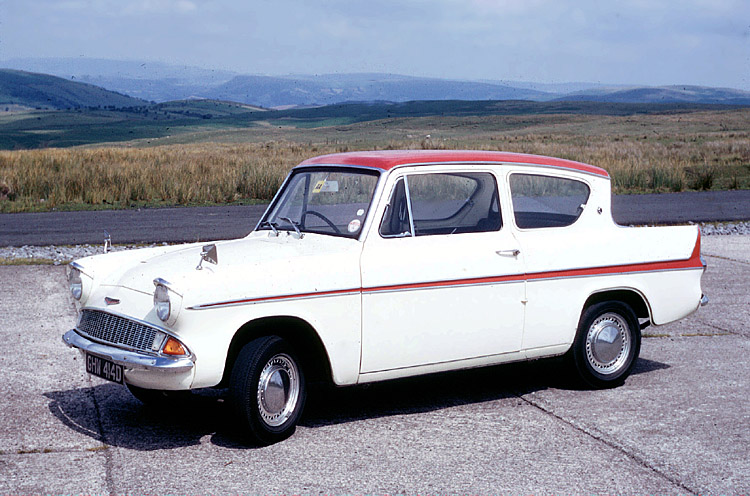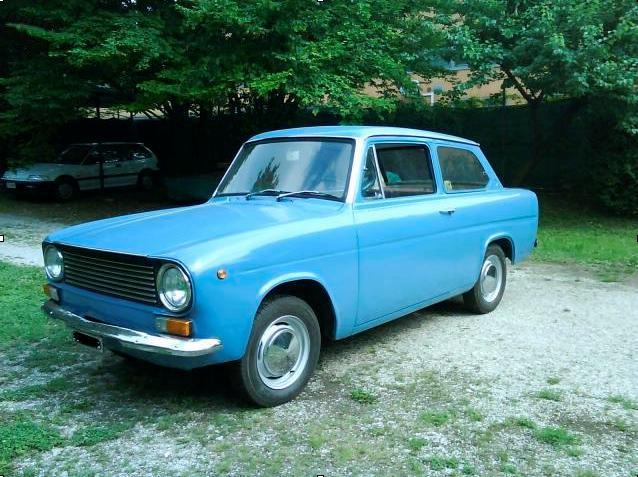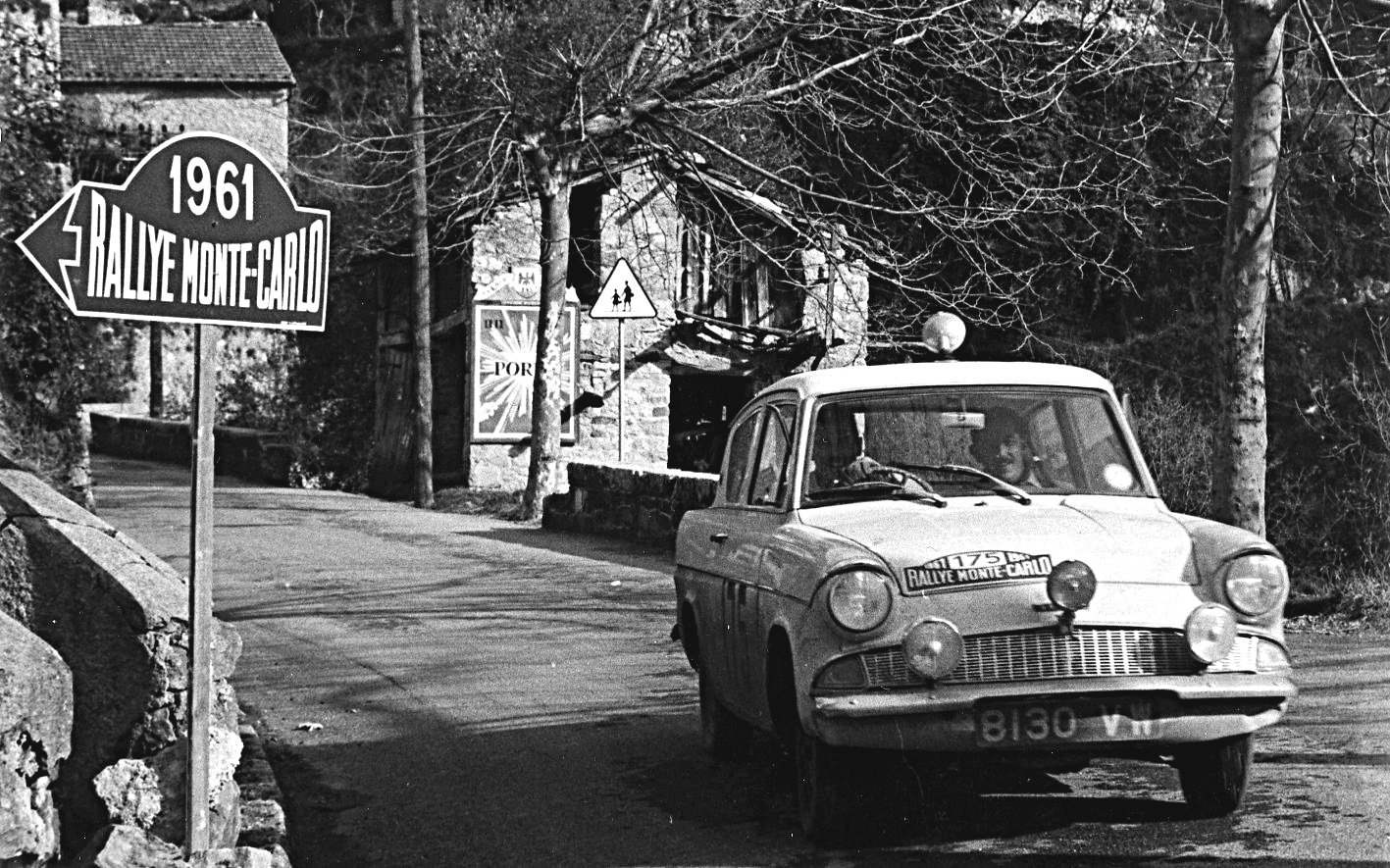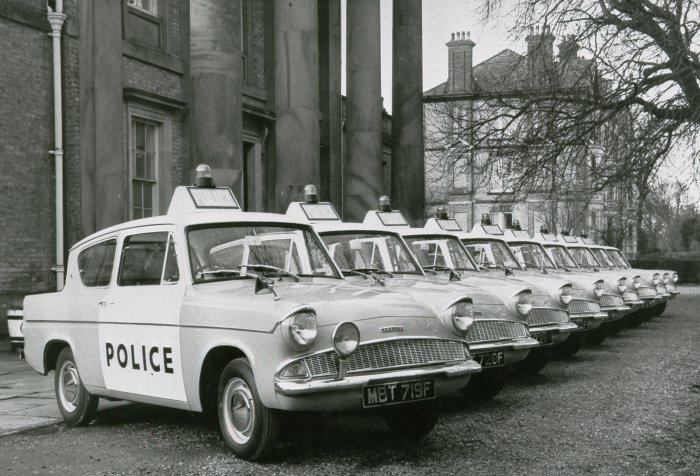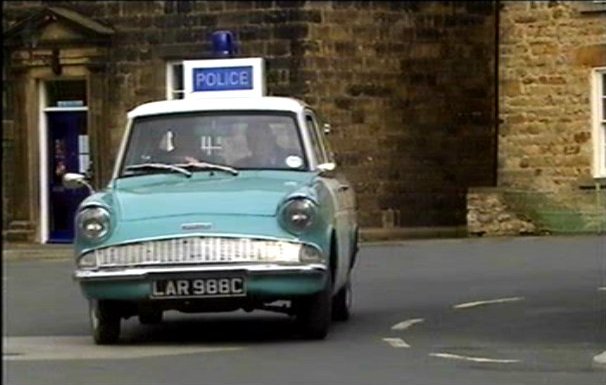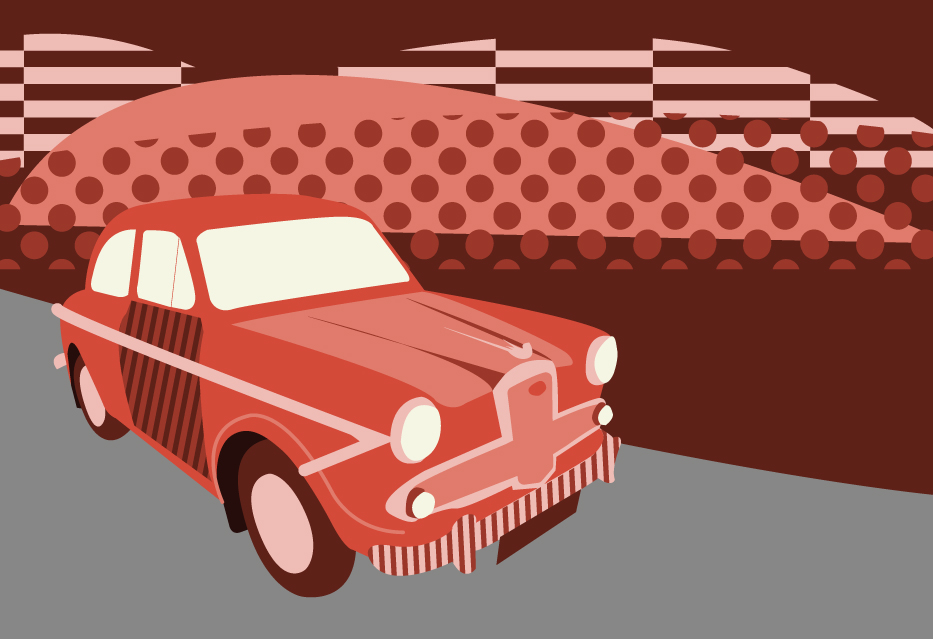The Ford Anglia is a rarity among classic cars – it’s immediately recognised all over the world by children and young people, even if it’s as “the Harry Potter car” and not by its given name.
But among the older generation, the Anglia was already a well-known and well-loved family car long before J K Rowling plucked the forerunner to the Ford Escort from her own memory banks and made it fly into the global spotlight.
We take a look at the history of the Anglia, focusing on the 105E, which sold more than a million between 1959 and 1967.
The Anglia name dates right back to 1939, when the E04A was the smallest model in the Ford range – a sit-up-and-beg, budget car powered by a 933cc side-valve engine.
Production was interrupted for three years after 1942 as Ford’s factory joined the war manufacturing effort and, when the car was replaced by the E494A in 1948, 55,807 had been made.
Its successor was merely a makeover, with a new front end, larger 1172cc, 10hp engine and was once again aimed squarely at the cheap end of the market.
Indeed, at launch it was Britain’s lowest-priced four-wheeled car, costing just £309 including taxes, and reaching a top speed of 57mph.
More than 100,000 were sold when it was replaced by the 100E in 1953, but the car continued in Ford Popular guise until 1959.
The all-new Anglia
The motoring world was changing fast in the 1950s, and cars still based on pre-war designs simply wouldn’t cut it anymore.
Out went the upright stance of the early Anglia, and in came a modern, three-box design in the shape of the all-new, two-door Anglia 100E, alongside a four-door version named the Prefect.
Under the bonnet, things were not quite so modern, with an 1172cc side-valve engine sharing the bore and stroke of its predecessor, but with larger bearings and inlet valves and a new cooling system.
The Anglia was going up in the world, however – a second windscreen wiper was added at no extra cost!
As before, however, they were still vacuum-operated and were notorious for slowing down, or even stopping, at higher speeds or when overtaking.
The new engine, while still antiquated in concept, pumped out an improved 36bhp and propelled the Anglia to 70mph, passing 60mph in 29.4 seconds
Unitary construction was adopted for the first time and the suspension evolved, with McPherson struts at the front and anti-roll bar and semi-elliptic leaf springs at the rear.
Facelifted in 1957, with a refreshed face, larger rear window, larger tail lights, and chrome bumpers, the car sold well throughout its life.
By 1959, when the new, boldly-styled 105E took over, 345,841 had rolled off the production line.
Birth of the 105E
In 1959, the Anglia 105E was one of three new British cars that made a significant mark on the motoring world.
While the Mini changed everyone’s perception of what a small car could be, the Triumph Herald and the Anglia revolutionised their respective manufacturers’ public image with hitherto unseen sharp, angular styling.
The Anglia, in particular, caught the eye with its transatlantic rear fins, reverse-rake rear window and hooded headlights, a radical departure for Ford in the UK and the product of a development centre opened in Birmingham in the mid-1950s.
That Americanized styling was perhaps not surprising given the role played in the car’s development of Elwood Engel, a visiting designer from Ford USA who was credited with many of the car’s features.
Just as the design was a big step forward for Ford in the UK, the engine also marked a huge advancement over its predecessors.
Gone was the ageing side-valve unit, replaced by a sweeter new 36bhp “Kent” 997cc overhead valve straight-four with an oversquare cylinder bore married to Ford’s first ever four-speed manual gearbox fitted to a production saloon, with synchromesh on the top three gears.
The vacuum-powered windscreen wipers were banished in favour of an electrical set-up, while stopping power was provided by drums all round, with steering courtesy of the recirculatory ball system.
Just two, two-door models were offered at launch, the sparsely-furnished Standard and the more upmarket Deluxe, which featured a full-width chrome grille.
Buyers who shelled out £589 for the Standard had to make do without such luxuries as a glovebox lid, passenger sunvisor and carpets, but an extra £21 (about £470 today) bought you those plus chrome side stripes, chrome rear lamp units, optional two-tone paintwork, and opening rear quarter windows. A heater, though, was still an optional extra…
Before subjecting the new car to the rigours of a motoring journalist’s road test and the public, Ford put the Anglia through a gruelling series of tests over 500,000 miles.
From the Alaska Highway to the mud tracks of Africa, Ford’s test drivers pounded the car with hard, round-the-clock driving in an effort to expose weaknesses.
Cold starting, heater efficiency and roadholding in ice and snow were tested in chilly Norway, while dust and suspension tests were carried out over rough tracks in East Africa in altitudes of 6,000ft and in temperatures over 35C, where roaming wild animals were a constant hazard.
Drivers took to Germany’s Autobahns for high-speed testing, while others put the car through its paces in the Australian bush and the wilds of Canada.
More than 30 vehicles were used, with the most unfortunate group stopped by German police on suspicion of carrying drugs in a night-time load test in the Ardennes near the Belgian border.
Police were only satisfied after the car was completely emptied of its cargo of 50lb bags of sand.
Eventually, after the most brutal testing regime of any new Ford, the Anglia was ready to be unveiled to a watching world.
Like our illustration of the Ford Anglia at the beginning of the article?
Download a free high-quality poster version here.
First impressions
On September 23, 1959, Ford pulled out all the stops to launch the Anglia, along with the new Popular (the old Anglia 100E) and the updated Prefect, hiring the Crystal Palace for the occasion.
Motor Sport magazine was among those invited to see, and drive, the “World’s Most Exciting Small Car”, as Ford’s ad men billed the new motor.
Guests were greeted in a “gay lounge of vast dimensions” and lunched “in an even more imposing dining-hall, while outside in the sunshine every conceivable Ford car and commercial vehicle was displayed, including a selection of historic vehicles which have carried the illustrious name of Ford since the era of the model-T”.
We’d love to see a video of what came next – “a comic sketch wherein a confirmed Volkswagen enthusiast is introduced to the new Anglia and made to realise what a relatively inferior car the VW is when compared to the 1959 Ford”.
The VW in question was presumably a Beetle, and Ford’s publicity man went on to list how the Anglia won hands down when it came to economy, speed, legroom and weight distribution.
Our man from Motor Sport was less than impressed at a “petty” attempt to “‘take the micky’ out of a well-proven, low-price design”.
“Another stunt, as improbable as the other was indiscreet, was seen when 14 hefty lads emerged from the Anglia to demonstrate the generous capacity of its body and boot!”
Sadly, this display of “bull” (Motor Sport’s word, not ours), appears to have been lost to history, but this launch video, a superb slice of retro cheese, has been archived for our delight.
But what of the car itself? Journalists were given the chance to drive various Anglias around most of the pre-war Crystal Palace circuit, reaching “some 55mph” along the top straight.
During the course of the demonstrations and tests, Motor Sport tells us “the only casualties we observed concerned a punctured tyre, two minor prangs and an engine failure”. So that’s all right then!
We’re told that the new gearbox “is a delight to handle and the exciting ‘oversquare’ engine has an exceedingly light throttle to which it responds admirably”.
Steering is described as light but “rather dead”, with faint understeer until pronounced body roll induces oversteer, while the “soft, comfortable suspension” affords excellent control.
The only “startlingly new aspect” of the Anglia was the reverse-raked rear window, which meant no rear parcel shelf, but did allow for the boot to open wide.
Over in America, Motor Life magazine went so far as to say the new high-revving engine “can almost be called radical”, with its “extremely oversquare” dimensions and hollow, three-bearing crankshaft.
Despite holding some reservations about the Anglia’s gear ratios, the magazine praised the transmission as “one of the best yet developed in a car in this class and shifts smoothly, engages precisely and is fast either up or down”.
Motor Life concluded that the American looking for a small car could do worse than plump for the Anglia, which it says “handles better, performs better and has better economy” than its predecessor.
Still in America, Sports Cars Illustrated magazine lived with an Anglia for a month and found that the new styling “excited admiration everywhere”.
“We found the female reaction almost invariably began, ‘It’s so cute!’”
Like our illustration of the Ford Anglia at the beginning of the article?
Download a free high-quality poster version here.
Arrival of the Anglia 123E Super
After such a flying start to its life, the Anglia range quickly developed, with an estate version joined by 105E-based Thames vans in 1961.
But it was a year later that the Anglia received its first significant upgrade in the shape of the faster and more luxurious 123E Super, with a larger 1198cc engine shared with the Cortina producing 48.5bhp.
The top of the range car boasted twin chrome side stripes, contrasting coloured roof and side flash, distinctive wheel trims, and synchromesh on first gear.
Inside, leather was an option for the new moulded pvc seats, while carpets replaced moulded rubber, a cigarette lighter, screen washers and twin horns were standard along with an upgraded heater.
Power was up 25 per cent on the 997cc engine, with a weight increase of only 12lb, resulting in an increased top speed of 84mph, up from 79mph.
The sprint, if such a term is even appropriate, to 70mph was cut dramatically from 51.5 seconds to 33.4 seconds, with Autocar reporting in December 1962 that “for motorway cruising 75mph is maintained happily with very little engine noise”, returning 28mpg at such speeds, touching 40mpg at slower cruising speeds.
“This engine has a surprising amount of ‘bite’, and provided the gearbox is used the car is very brisk away from a standstill and nips through traffic in an impressive manner,” according to the road tester.
“It has one of the easiest, crispest and most pleasant gear changes on the market, the synchromesh mechanism standing up to the quickest possible movements of the lever.”
Inside, the interior “gives a splendidly light and airy impression, all-round visibility being very good, though again, for that most unfortunate of motorists the ‘tall driver’, there is a tiresome unwiped area of windscreen high at the outside right”.
In summary, the magazine was full of praise for the upgraded Anglia: “Economical, robust, safe, easy to drive and extremely ‘biddable’, the Anglia Super 1200 offers everything to be expected of a strictly four-seater family car – plus more lively performance, a degree of attention to detail and superior finish that raise it above the run of small, cheap saloons.”
The same car was also sold across Europe, with one continental-only variant – the Anglia Sportsman – carrying its spare tyre on the back.
Sales in some European countries were not as strong as in the car’s home market, and Ford of Italy opted to do their own thing, employing Michelotti to restyle the Anglia, changing most of the body panels and doing away with that reverse sloped rear window, renaming the car the Ford Anglia Torino.
The result was a little boxy and bland compared to the striking original and, although more than 10,000 sold in Italy, the Italians’ aim of exporting the car to other European countries fell flat and production lasted little more than a year between 1964 and 1965.
Six years into its production run, the Anglia was still selling well, and the estate was proving to be “a brisk, dual-purpose vehicle with compact dimensions and good carrying capacity”, according to Autocar in August 1965.
The 1200 engine remained “flexible and lively (top of its class on all counts) and surprisingly economical”, while the magazine’s own fleet experience showed the model to be “particularly trouble-free and reliable in service”, with only the roadholding and driver comfort starting to show its age.
Motorsport success
The Anglia had barely been launched when Formula Junior and other motorsport groups latched on to the tuning potential of Ford’s new engine, with Keith Duckworth of Cosworth Engineering getting hold of two of the new engines.
When Colin Chapman’s Lotus 18 joined the Formula Junior fray in 1960, with none other than a young Jim Clark at the wheel, the car was powered by the Cosworth III engine – a tuned version of the humble Anglia’s lump.
The Anglia also enjoyed itself on the rally circuit, with Ford entering the car into the RAC International Rally of Great Britain in its launch year and, between then and 1965, it was a regular at the Monte Carlo Rally and also won the 1966 British Saloon Car Championship (the forerunner of today’s BTCC), piloted by John Fitzpatrick.
With the high-revving engine proving almost unbreakable, even in tuned form, it was no surprise that the reliable Anglia was such a success among road users, and no-one demonstrated the engine’s durability more than twin brothers Tony and Michael Brookes.
In October 1962, the 24-year-olds and a group of friends captured six International Class G World Records at the Montlhéry Autodrome near Paris in a 105E fitted with the £13 Ford Performance Kit.
Averaging 83.47mph, the event took place over 4, 5, 6 and 7 days and nights and 9,300 and 12,400 miles, and only tyre changes were required.
Another pair of brothers, Mike and John Young, prepared Anglias for racing under the name Superspeed Conversions, operating from a garage behind the Ford dealership at Ilford, East London in the 1960s.
They prepared 1000, 1300 and 1650cc engined cars for various championships and, in 1965, when their cars were almost unbeatable, the Youngs celebrated the success of the 1650cc cars by producing six, less highly-tuned road-going versions.
Supplied by Ford as 1200 Supers in Monaco Red with black trim, Superspeed stripped down and rebuilt the cars with a tuned engine; close ratio gearbox, suspension and front brakes from a Lotus Cortina; Bullet Wing Mirrors, and an upgraded works rally dash supplied by Ford.
Only one of the six cars made, surely the ultimate road-legal Anglia, is known to remain.
Like our illustration of the Ford Anglia at the beginning of the article?
Download a free high-quality poster version here.
Panda cars
As well as being one of the most popular small family cars of the 1960s, the Anglia has a place in law enforcement history as the very first Panda car.
During the 1950s and 60s, the “bobby on the beat”, either on foot or riding a bicycle, was becoming over-stretched as the population boomed and officers had ever-wider areas to cover.
The answer was “unit policing” and Panda cars, first introduced in the Kirby area of Liverpool in 1965 with five pale blue Anglias with a distinctive white band on the roof and front doors.
Now, pandas clearly aren’t blue, but the nickname caught on thanks to the Anglia’s appearance in police TV programmes such as Z-Cars, watched in black and white, and the nickname became an acronym rather than the other way around: Patrol And Neighbourhood Deployment Area cars.
Cheap, economical, reliable and easy to manoeuvre, the Anglia proved a popular choice (along with the Mini) among police forces across the country, so much so that Ford had them painted and fully finished to police specification on the Halewood production lines.
Those too young to remember the Z-Cars Anglias may well have seen a Panda car used regularly by the Ashfordly Police in Heartbeat.
Harry Potter Ford Anglia
It’s the most famous flying car since Chitty Chitty Bang Bang, and without doubt the most well-known Ford Anglia in the world.
The “Harry Potter car”, as those of a younger generation will now identify every Anglia, wasn’t actually owned by Potter himself, but by Ron Weasley’s dad Arthur, who enchanted it to not only fly, but also to become invisible and fit eight people, six trunks, two owls, and a rat comfortably.
The car appeared in Harry Potter and the Chamber of Secrets, most famously to fly Ron and Harry to Hogwarts, crashing into the Whomping Willow, disgorging its occupants and heading off under its own steam into the Forbidden Forest.
The car returns to save Harry, Ron and Hagrid’s dog, Fang, from Aragog’s family towards the end of the school year, before reversing back into the Forest and disappearing forever.
J K Rowling recently revealed that the inspiration for the car, and indeed the character of Ron Weasley, was old school friend Sean Harris, who she describes as “getaway driver and foul-weather friend”.
The author revealed on her website how Harris helped her through some difficult family times after he joined her school, Wyedean Comprehensive, Chepstow, Monmouthshire.
The pair became firm friends, mainly because Harris had a car, a Ford Anglia.
Rowling said: “That turquoise and white car meant freedom and no more having to ask my father to give me lifts, which is the worst thing about living in the countryside when you are a teenager.
“Some of the happiest memories of my teenage years are zooming off into the darkness in Sean’s car.
“Harry was rescued by that car, just as the car rescued me from my boredom.”
And while Ron’s car didn’t exactly rescue the Anglia from obscurity, it did bring it to a whole new audience.
Slightly less famously, and less heroically, an Anglia also featured in cult 80s TV show The Young Ones, painted yellow with red flames on the sides and owned by Vyvyan Basterd.
The end of the line
With development work on the all-new Ford Escort well under way, the ageing Anglia headed into its twilight years at the height of the Swinging Sixties.
In 1966, two special editions were released based on both the Deluxe and Super models, available in Venetian Gold or Blue Mink metallic paint with black interior trim.
In all, 250 models were sold in blue, and 500 in gold, out of a total production run of 1,288,956 Anglias over eight years from 1959 to 1967.
It was still possible to buy a new Anglia once the Escort hit the streets as dealers still had stock to clear to make room for the new car.
And the good news for buyers was that, by 1967, the standard Anglia cost less than it did at launch eight years earlier, £535 compared with £589. The Deluxe was down from £610 to £596.
The Anglia may be long gone, but more than 2,000 examples of all shapes survive on the roads today and, thanks in part to Harry Potter, it will never be forgotten.
Insurance from Adrian Flux
Get competitive classic car insurance for your Ford Anglia from Adrian Flux.
Features can include:
- Agreed value
- Limited mileage discounts
- Owners club discount
- Laid up cover
- Wedding hire cover



